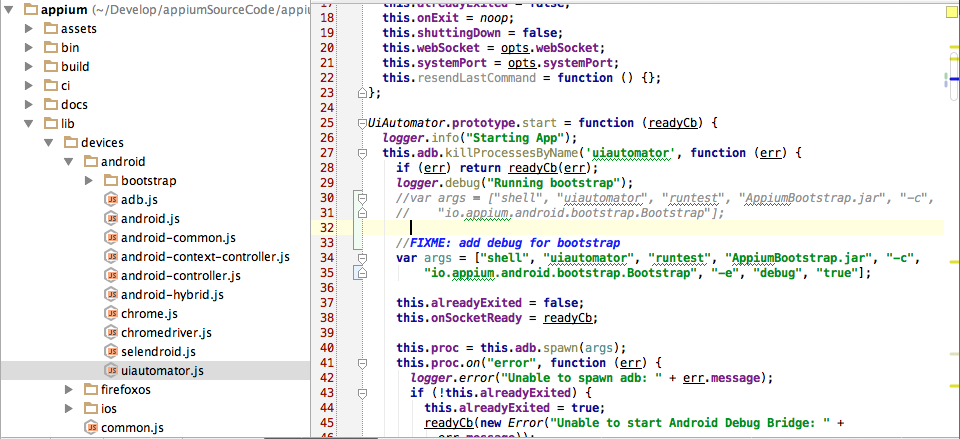前言
之前看到一个帖子(appium 1.3.4.1 版 sendkey 错误),里面提到了在 appium 1.3.4.1 中用 sendKeys 输入文本会变成追加文本,而 appium 1.2.4 则没有这个问题。同时如果 sendKeys 前有先 clear 也不会出现这个问题。周末有时间在源码环境下探究了一下具体原因,结果不仅发现了具体原因,还发现了一个小 bug。
调试环境
appium 版本:1.3.6(REV faf0873919a70c930b32df48e7653e8fe830a142)
所用 IDE: WebStorm(node.js 部分),IDEA(Android 上使用的 bootstrap 部分)
源码修改: 为了能对 bootstrap 进行远程调试,我在appium/libs/devices/android/uiautomator.js的启动参数中添加了-e debug true这个参数:

被测 app: 自行制作的 app,里面只有一个界面,界面中有一个 editText 控件,控件的默认值为 “中文”(非 hint text)。控件具有 content-description,因此脚本中使用 id 来查找控件。
注意:添加了这个参数后 bootstrap 启动时会一直等待直到有 debugger 联系到它。所以非 debug 用途请勿做此修改。
至于如何设置远程调试 bootstrap,调试方法和调试 Android UIAutomator 一样。由于不是本文的重点,因此不再仔细介绍,有兴趣的同学请自行搜索。
SendKeys 工作过程 log 分析
SendKeys 从 appium server->bootstraps->最终输入 的完整 log 如下:
info: --> POST /wd/hub/session/be7c34f0-e12d-4368-9f80-c116e0cc3990/element/1/value {"sessionId":"be7c34f0-e12d-4368-9f80-c116e0cc3990","id":"1","value":["f","i","r","s","t"]}
info: [debug] Pushing command to appium work queue: ["element:setText",{"elementId":"1","text":"first","replace":false}]
info: [debug] [BOOTSTRAP] [debug] Got data from client: {"cmd":"action","action":"element:setText","params":{"elementId":"1","text":"first","replace":false}}
info: [debug] [BOOTSTRAP] [debug] Got command of type ACTION
info: [debug] [BOOTSTRAP] [debug] Got command action: setText
info: [debug] [BOOTSTRAP] [debug] Attempting to clear using UiObject.clearText().
info: [debug] [BOOTSTRAP] [debug] Sending plain text to element: 中文first
info: [debug] [BOOTSTRAP] [debug] Returning result: {"value":true,"status":0}
info: [debug] Responding to client with success: {"status":0,"value":true,"sessionId":"be7c34f0-e12d-4368-9f80-c116e0cc3990"}
info: <-- POST /wd/hub/session/be7c34f0-e12d-4368-9f80-c116e0cc3990/element/1/value 200 9119.841 ms - 76 {"status":0,"value":true,"sessionId":"be7c34f0-e12d-4368-9f80-c116e0cc3990"}
简单说一下各个 log 是什么意思:
info: --> POST /wd/hub/session/be7c34f0-e12d-4368-9f80-c116e0cc3990/element/1/value {"sessionId":"be7c34f0-e12d-4368-9f80-c116e0cc3990","id":"1","value":["f","i","r","s","t"]}
表示 server 接收到一个 post 类型的 http 请求,post 的 url 是/wd/hub/session/be7c34f0-e12d-4368-9f80-c116e0cc3990/element/1/value,post 请求的内容 (即 http 协议中的的 body 部分) 为{"sessionId":"be7c34f0-e12d-4368-9f80-c116e0cc3990","id":"1","value":["f","i","r","s","t"]}
此部分的通讯遵循 webdriver 协议,无论哪个 client 发出来都是采用这个格式
info: [debug] Pushing command to appium work queue: ["element:setText",{"elementId":"1","text":"first","replace":false}]
表示 server 把["element:setText",{"elementId":"1","text":"first","replace":false}]这个命令放到待处理命令序列中。
info: [debug] [BOOTSTRAP] [debug] Got command of type ACTION
info: [debug] [BOOTSTRAP] [debug] Got command action: setText
表示 bootstrap 收到类型为 action,名称为 setText 的命令
info: [debug] [BOOTSTRAP] [debug] Attempting to clear using UiObject.clearText().
表示执行UiObject.clearText()来清除元素的现有文字
info: [debug] [BOOTSTRAP] [debug] Sending plain text to element: 中文first
表示在元素中输入中文first
info: [debug] [BOOTSTRAP] [debug] Returning result: {"value":true,"status":0}
表示 bootstrap 返回执行结果{"value":true,"status":0}
info: [debug] Responding to client with success: {"status":0,"value":true,"sessionId":"be7c34f0-e12d-4368-9f80-c116e0cc3990"}
表示 appium server 准备返回{"status":0,"value":true,"sessionId":"be7c34f0-e12d-4368-9f80-c116e0cc3990"}给发起请求的 client
info: <-- POST /wd/hub/session/be7c34f0-e12d-4368-9f80-c116e0cc3990/element/1/value 200 9119.841 ms - 76 {"status":0,"value":true,"sessionId":"be7c34f0-e12d-4368-9f80-c116e0cc3990"}
表示 appium server 返回 url 为/wd/hub/session/be7c34f0-e12d-4368-9f80-c116e0cc3990/element/1/value,http 状态码为 200,内容为{"status":0,"value":true,"sessionId":"be7c34f0-e12d-4368-9f80-c116e0cc3990"}的数据包给 client
提出疑问
通过分析,里面有几个让人在意的地方:
- 从 client 给 server 的请求中只有
sessionId,id和value三个参数,而 server 加入到工作序列的参数除了命令名称外还增加了replace参数(那个帖子中还有unicodeKeyboard参数),增加的replace和unicodeKeyboard参数到底是以什么为根据来确定的
- bootstrap 中获得的 setText 的 value 是
first,为何实际在 bootstrap 输入的是中文first?
- 实际测试中,当 appium server 返回操作成功的信息时(bootstrap 也显示输入了值),实际上此时应用中 editText 控件的内容为空,即清除内容后没有按照 log 所说输入
中文first
带着这几个问题,我们开始分析及调试源码。
解决疑问
所有命令都是先通过 routing 分析来源来调用对应的方法。因此先查 routing:
appium/lib/server/routing.js
...
rest.post('/wd/hub/session/:sessionId?/element/:elementId?/value', controller.setValue);
...
rest.post('/wd/hub/session/:sessionId?/appium/element/:elementId?/value', controller.setValueImmediate);
rest.post('/wd/hub/session/:sessionId?/appium/element/:elementId?/replace_value', controller.replaceValue);
找到三个和 serValue 相关的命令。通过 url 可以看出只有setValue方法是遵循 webdriver api 的,其它两个方法都是 appium 自己另外添加的。这里的controller方法的源码分别如下:
appium/lib/server/controller.js
...
exports.setValue = function (req, res) {
var elementId = req.params.elementId
// spec says value attribute is an array of strings;
// let's turn it into one string
, value = req.body.value.join('');
req.device.setValue(elementId, value, getResponseHandler(req, res));
};
exports.replaceValue = function (req, res) {
var elementId = req.params.elementId
// spec says value attribute is an array of strings;
// let's turn it into one string
, value = req.body.value.join('');
req.device.replaceValue(elementId, value, getResponseHandler(req, res));
};
...
exports.setValueImmediate = function (req, res) {
var element = req.params.elementId
, value = req.body.value;
if (checkMissingParams(req, res, {element: element, value: value})) {
req.device.setValueImmediate(element, value, getResponseHandler(req, res));
}
};
...
此处req.device会根据平台不同使用不同的实现来执行。此处我们仅关注 android 平台,它的实现方法如下:
appium/lib/devices/android/android-controller.js
...
androidController.setValue = function (elementId, value, cb) {
var params = {
elementId: elementId,
text: value,
replace: false
};
if (this.args.unicodeKeyboard) {
params.unicodeKeyboard = true;
}
this.proxy(["element:setText", params], cb);
};
androidController.replaceValue = function (elementId, value, cb) {
var params = {
elementId: elementId,
text: value,
replace: true
};
if (this.args.unicodeKeyboard) {
params.unicodeKeyboard = true;
}
this.proxy(["element:setText", params], cb);
};
...
androidController.setValueImmediate = function (elementId, value, cb) {
cb(new NotYetImplementedError(), null);
};
...
可以看到replace和unicodeKeyboard参数都是在这里加入的。其中setValue方法和replaceValue方法唯一区别是replace参数的值,unicodeKeyboard是根据 server 的unicodeKeyboard参数值 (就是启动 session 时的传入的unicodeKeyboard参数) 决定的。而setValueImmediate方法还没实现,因此不再探究。
至此,第一个疑问解决。repalce和unicodeKeyboard是在appium/lib/devices/android/android-controller.js中根据调用的方法来设定的。其中setValue的replace参数值固定为false
bootstrap 部分
关于 bootstrap 源码的分析我主要参考了http://www.it165.net/pro/html/201407/17696.html,里面已经大致说明了setText方法的实现是放在bootstrap/src/io/appium/android/bootstrap/handler/SetText.java中:
appium/libs/devices/android/bootstrap/src/io/appium/android/bootstrap/handler/SetText.java
...
boolean replace = Boolean.parseBoolean(params.get("replace").toString());
String text = params.get("text").toString();
...
boolean unicodeKeyboard = false;
if (params.get("unicodeKeyboard") != null) {
unicodeKeyboard = Boolean.parseBoolean(params.get("unicodeKeyboard").toString());
}
String currText = el.getText();
new Clear().execute(command);
if (!el.getText().isEmpty()) {
// clear could have failed, or we could have a hint in the field
// we'll assume it is the latter
Logger.debug("Text not cleared. Assuming remainder is hint text.");
currText = "";
}
if (!replace) {
text = currText + text;
}
final boolean result = el.setText(text, unicodeKeyboard);
if (!result) {
return getErrorResult("el.setText() failed!");
}
...
return getSuccessResult(result);
...
从这里看到,从获得命令到完成输入一共有以下步骤:
- 判断并存储
replace, text, unicodeKeyboard参数的值
- 通过
getText获取当前元素的文字,存到currText中
- 使用
new Clear().execute(command);清除当前元素的所有文字
- 再次获取当前元素文字。如果文字仍不为空,认定它是 hint text 并把
currText置空(由于此处也有可能是 clear 方法出错导致没有 clear 成功,因此留了一个 log 说明假设还存在的 text 是 hint text)
- 如果
replace不是 true,在text前面加入currText。
- 调用
setText方法执行实际输入。
在这里解答了第二个疑问:sendKeys 的文字会在前面加了 “中文” 这两个字符是因为它在第 5 步加入了元素原来的 text 内容。即采用追加方法来输入文本。
为何早期 appium 版本 (如 1.2.4) 没有采用追加,而现在采用追加 导致破坏了向下兼容性呢?答案是 早期版本的实现实际上是错的。
webdriver api 中对于 sendKeys 方法的描述明确说明了 SendKeys 的实现应该是 在当前文本框的文字最后采用追加形式来输入文本。 要实现清除文本框内容后输入文本应该在脚本中采用先 Clear 后 SendKeys 的方式。
到这里为止,已经基本解决了帖子中的问题。但对于第三个疑问,目前还没看到哪里出问题。而且 UIAutomator API 的 setText 方法并没有uincodeKeyboard这个参数,所以推测这里的setText并不是 UiObject 的 setText 方法。再来看看这里的el.setText(text, unicodeKeyboard)的实现:
appium/libs/devices/android/bootstrap/src/io/appium/android/bootstrap/AndroidElement.java
...
AndroidElement(final String id, final UiObject el) {
this.el = el;
this.id = id;
}
...
public boolean setText(final String text, boolean unicodeKeyboard)
throws UiObjectNotFoundException {
if (unicodeKeyboard && UnicodeEncoder.needsEncoding(text)) {
Logger.debug("Sending Unicode text to element: " + text);
String encodedText = UnicodeEncoder.encode(text);
Logger.debug("Encoded text: " + encodedText);
return el.setText(encodedText);
} else {
Logger.debug("Sending plain text to element: " + text);
return el.setText(text);
}
}
...
可以看到,这里的 el 是 UiAutomator 的 UiObject 对象了。然后根据setText函数看到输入文本的具体步骤:
- 判断
unicodeKeyboard是否为true,如果是还要检查需要输入的文本是否需要进行 encode,两者均为true,用UnicodeEncoder.encode(text)把文本编码,然后再把编码后的文本发给 UiObject 的setText方法
- 如果不符合上面的条件,直接调用 UiObject 的
setText方法。
咋看之下没啥问题。但我在调试过程中使用 Evaluate Expression 功能单独运行setText("中文"),结果 文本框没有输入任何值,但返回值为true,而setText("first")则能正常输入!
由此解决了第三个疑问,同时发现一个 bug:
当没有设定unicodeKeyboard为true的情况下,直接使用 sendKeys 方法,当 editText 的默认值(非 hint text)含有非 ASCII 字符时,会遇到脚本没有报错,但实际上没有输入任何内容的情况
从用户角度,在unicodeKeyboard为false情况下接收到含有无法输入的字符时,应该直接报错并说明无法输入。否则这个 bug 的性质就如同 你添加了一个记录,系统显示添加成功,但实际上没有添加进去这么坑爹。
从哪个版本开始 sendKeys 变成了追加:
经过在 appium 的 repo 中查询,查到把 sendKeys 改为追加的 commit 是:https://github.com/appium/appium/commit/f70ba32a76c486f0609c99c4074bac318fdc7195
这个 commit 存在于v1.2.2及以后的所有 tag 中,所以应该1.2.2以后的 appium 都变成了追加模式。至于帖子中为何说1.2.4还是替换模式,由于手上没有1.2.4的 appium,所以暂时还不清楚。
总结
-
sendKeys在 webdriver API 中本来就是在文本后追加。Appium 早期版本(1.2.2 以前)错误地把它实现成了替换当前文本,在 1.2.2 后修复。
- 如果想实现替换当前文本,可以先使用
clear方法清空文本,再使用sendKeys方法输入文本。
- 在不确定文本框默认值是否含有非 ASCII 字符前,如无特殊原因,测试 android 应用请尽量设置
unicodeKeyboard为true(关于 unicode 的具体说明详见https://github.com/testerhome/appium/blob/master/docs/cn/writing-running-appium/unicode.cn.md)。

↙↙↙阅读原文可查看相关链接,并与作者交流

